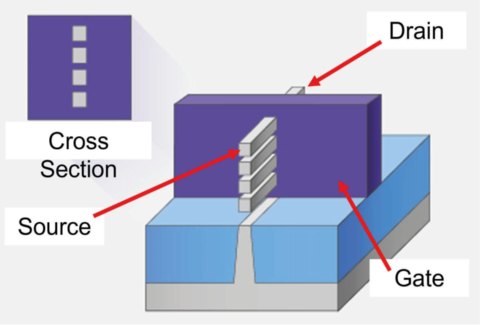Causal Green's function simulations of phonons for multiscale/multiphysics modeling of thermal transport in gate-allaround transistors
Summary
This project employs a causal Green’s function (CGF) method to model thermal transport in nanoscale semiconductors, overcoming limitations posed by the Fourier law of heat conduction.
This project will provide industry with a new, unique, and powerful simulation technique for semiconductors, which should be of direct and immediate interest to industry stakeholders.
Grand Challenge 4. Modeling and Simulating Semiconductor Materials, Designs, and Components
Description

Shown is a conceptual diagram of a gate-all-around (GAA) field-effect transistor. GAA transistors are the successor to “Fin” transistors (FinFETs) since GAA transistors can work at characteristic length scales below 7 nm. GAA transistors have many 3D interfaces, which poses a challenging boundary value problem during design analysis.
Heat management in modern semiconductor devices at nanoscal es is a multiscale and multiphysics problem of strong industrial interest. The power density in modern nanoscale devices becomes extremely high, whichcan drastically reduce the efficiency and the lifespan of the device. This problem necessitates powerful techniques for simulating phonon propagation in semiconductors, which is the basis of thermal conduction.
This project will demonstrate that a CGF method is ideally suited for such multiscale and multiphysics computations. This will directly benefit industry by offering a unique simulation technique that will reduce time and computational costs.
Additional Project Benefit:
Because of their very high computational efficiency, these Green’s function techniques will enable virtual experimentation – that means an industrial design engineer can address “What if” type questions in relatively short computational times. They will be able to try out many designs by doing inexpensive and safe virtual experiments on the computer rather than in the real lab.

